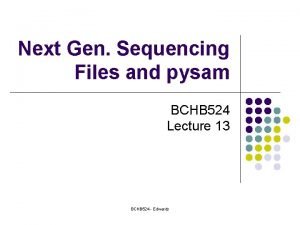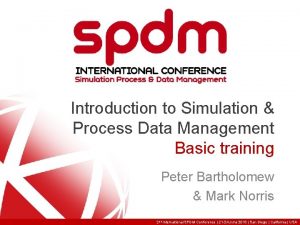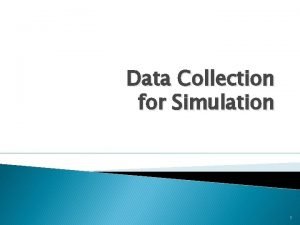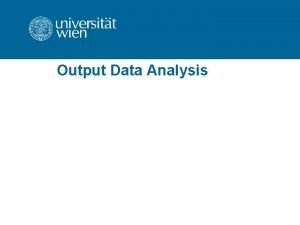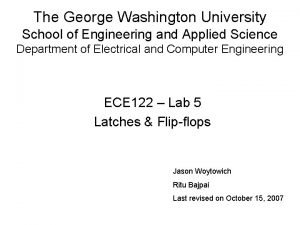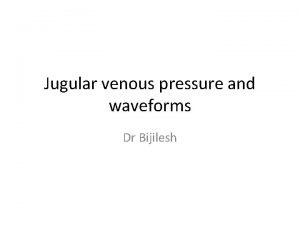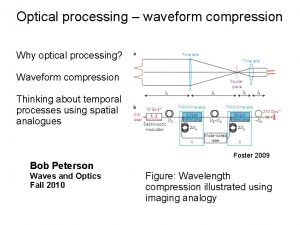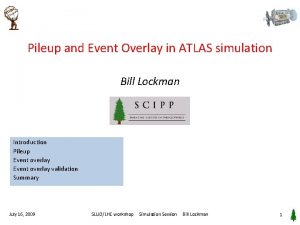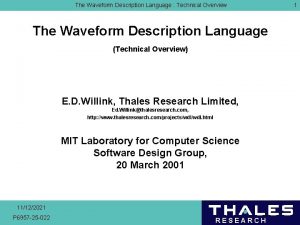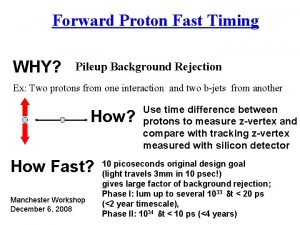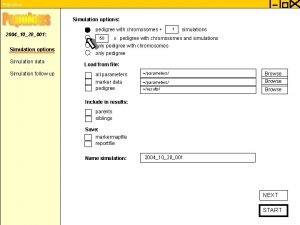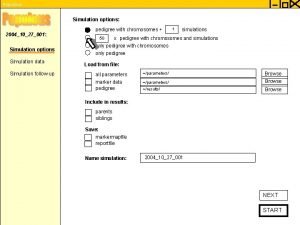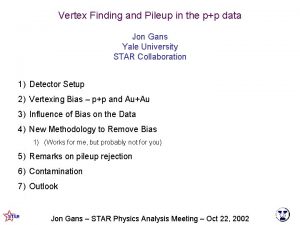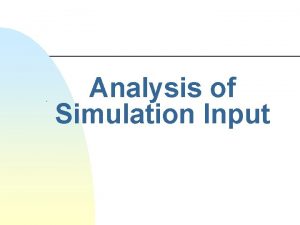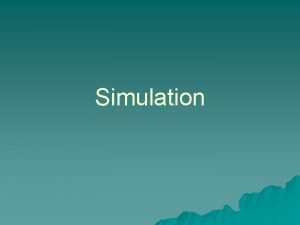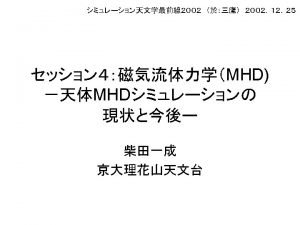Contents Why waveform Waveform data Waveform simulation Pileup



















- Slides: 19


Contents • • • Why waveform ? Waveform data Waveform simulation Pile-up rejection Summary 13/Sep/2005 日本物理学会 2005年秋季大会 @大阪市立大 2

Why use waveform data In theyield MEG experimentsignal background Photon m enn + g m eg all PMTs are read by g 52. 8 Me. V g a fast waveform digitizer m Using Lq. Xe as scintillator e • large light yield • short decay time • short radiation length m ? e Major background reject pile-up of g-rays • Prompt background Unsegmented • Accidental background detector Crucial for the MEG experiment and very difficult without waveform image 13/Sep/2005 日本物理学会 2005年秋季大会 @大阪市立大 3

Waveform data by Stefan Ritt Domino Ring Sampler (DRS) DRS Developed. NIM A 518(2004) 470 10 channels x 1024 bins ~10, 000/chn 13/Sep/2005 Xe waveform data were already taken successfully using prototype detector [m. V] Readout Shift Register Domino Circuit Analog sampling chip, switching capacitor circuits • Max sampling speed 4. 5 GHz (required 2. 5 GHz) • Sampling cells 1024 • 8 data ch, 2 calibration ch(voltage and time) / chip • Read out speed 40 MHz, 12 bits • Domino wave runs continuously, only stopped by the trigger 2. 5 GHz sampling Data analysis is going on. I reported at last meeting. . . 日本物理学会 2005年秋季大会 @大阪市立大 [msec] 4 Xe scintillation pulse

Waveform simulation 13/Sep/2005 日本物理学会 2005年秋季大会 @大阪市立大

Waveform Pulse shape is a consequence of various effects like, Scintillation process Light transport in the scintillator PMT response Shaping from circuit Cables Receiver (DRS) t= 45 nsec electron a Xe scintillation process for g Decay time 45 nsec PMT TTS 0. 75 nsec (Typ. ) TTS : Transit time spread of PMT for individual photoelectrons 13/Sep/2005 日本物理学会 2005年秋季大会 @大阪市立大 6

Waveform simulation 1. Sum up single electron pulses for all photoelectrons • • Single electron response spread by TTS (Gaussian). Arrival time of each scintillation photon tracked by MC simulation. 8000 p. e. 2. Shaped by low pass filter • RC shaping ( integration circuit ) • Time constant RC = 5 nsec 13/Sep/2005 –Data averaged pulse –Simulated pulse Simulated waveform is well fitted to real waveform. 日本物理学会 2005年秋季大会 @大阪市立大 7

Simulated waveform Now we can simulate waveform pulse by pulse. 2000 p. e. 500 p. e. Distribution of pulse width Fluctuation of pulse shape is well simulated pulse width [nsec] Data width: height 100 p. e. Pulse shapes are not constant especially for small pulses because of statistics. Simulation Due to DRS response for small pulses We succeed in simulating pulse shape properly 13/Sep/2005 日本物理学会 2005年秋季大会 After this, use these pulse simulated height [m. V] waveform for analysis @大阪市立大 8

Pile-up rejection 13/Sep/2005 日本物理学会 2005年秋季大会 @大阪市立大

Pile-up event Lq. Xe g 1 How to reject pile-ups ? distribution of PMT output pulse shape after DT g 2 # of p. e. DT = t 2 – t 1 E 1 + E 2 = 1 (signal energy) g 1 g 2 1 PMT output 日本物理学会 2005年秋季大会 2000 p. e. + 1600 p. e. , DT = 20 nsec 13/Sep/2005 @大阪市立大 10 0. 8 + 0. 2

Pile-up rejection How to find pile-ups ? Peak search method simplest way but powerful in case of large DT Take moving average and count peaks DT=75 ns, 2000 p. e + 400 p. e. Differential method powerful in case of DT around rise time Take differentiation and count its peaks 13/Sep/2005 DT=15 ns, 600 p. e. + 1600 p. e 日本物理学会 2005年秋季大会 @大阪市立大 Set threshold in peak finding with missrejection of non-pileup signal 11 < 0. 05%

Pile-up rejection Difficult to find pile-up by looking at individual PMT output. • # of photons for each PMT is small • # of PMTs which can observe event as a pulse is small • Noise such as microstructure in pulse shape for small signal Take sum of PMT outputs • Larger pulse • Microstructure in pulse shape disappear Sum of all PMTs for signal g 13/Sep/2005 日本物理学会 2005年秋季大会 @大阪市立大 12

Pile-up rejection • Taking all PMTs sum is not good from S/N viewpoint. • Sum in order of PMT output • How many PMTs to be summed ? 70% 40 90% # of PMTs 130 # of PMTs S/N can be improved considerably 13/Sep/2005 日本物理学会 2005年秋季大会 @大阪市立大 13

Rejection efficiency optimization l) a n ig E 1 13/Sep/2005 日本物理学会 2005年秋季大会 @大阪市立大 + E 2 (s 1 = 14

Rejection efficiency 60% DT 8 ns DT 50 ns DT 15 ns 13/Sep/2005 DT 100 ns Weak point • DT less than 10 nsec • Small pulse after large one 日本物理学会 2005年秋季大会 @大阪市立大 15

Summary • We Succeed in simulating waveform from LXe detector. • It indicates the detector response is well understood. • Algorithm for pile-up rejection is studied and is being optimized. • Pile-ups can be separated if , Eg: >5 Me. V, DT: >10 ns 13/Sep/2005 日本物理学会 2005年秋季大会 @大阪市立大 16

Next step • Rejection spatially separated pile-up using distribution of PMT outputs • Rejection efficiency against m g e g background 13/Sep/2005 日本物理学会 2005年秋季大会 @大阪市立大 17


DRS principle 0. 2 -2 ns Inverter “Domino” chain IN Waveform stored Out Clk Shift Register FADC 40 MHz “Time stretcher” GHz MHz 13/Sep/2005 日本物理学会 2005年秋季大会 @大阪市立大 19
 Pysam pileup
Pysam pileup Why why why why
Why why why why Don't ask why why why
Don't ask why why why Spdm (simulation process & data management)
Spdm (simulation process & data management) Simulation method of data collection
Simulation method of data collection Output data analysis
Output data analysis Dff waveform
Dff waveform Flip flop waveform
Flip flop waveform Neck veins waves
Neck veins waves Iabp waveform
Iabp waveform Cvp line monitoring
Cvp line monitoring Data domain fundamentals
Data domain fundamentals Fourier series periodic function examples
Fourier series periodic function examples 3 phase dual converter
3 phase dual converter Spectrogram adalah
Spectrogram adalah Sr latch waveform
Sr latch waveform 3 phase waveform
3 phase waveform Johnny sinze
Johnny sinze Icp waves a b c
Icp waves a b c Bldc waveform
Bldc waveform
